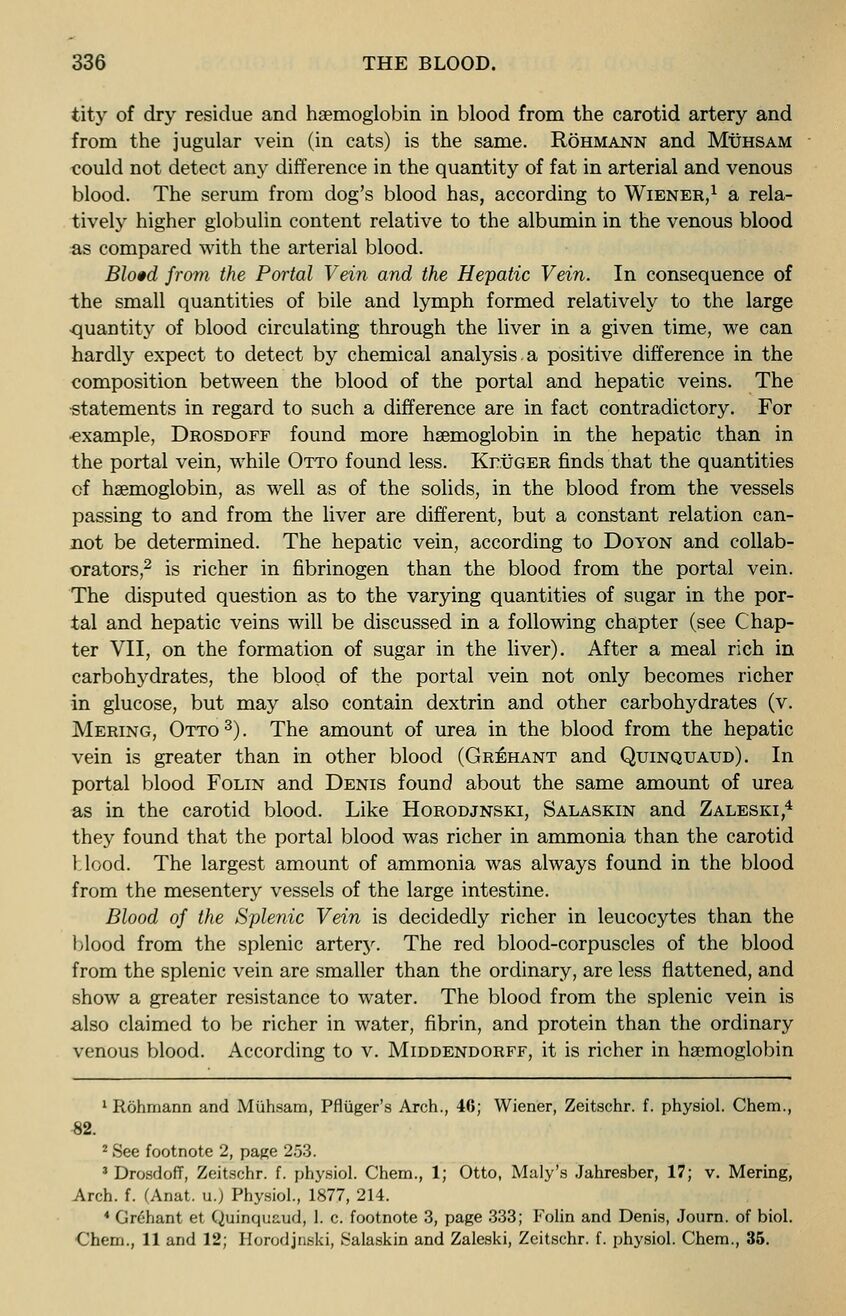
Full resolution (JPEG) - On this page / på denna sida - V. The Blood - IV. The Quantitative Composition of the Blood - The Composition of the Blood in Different Vascular Regions and under Different Conditions

<< prev. page << föreg. sida << >> nästa sida >> next page >>
Below is the raw OCR text
from the above scanned image.
Do you see an error? Proofread the page now!
Här nedan syns maskintolkade texten från faksimilbilden ovan.
Ser du något fel? Korrekturläs sidan nu!
This page has never been proofread. / Denna sida har aldrig korrekturlästs.
336 THE BLOOD.
tity of dry residue and haemoglobin in blood from the carotid artery and
from the jugular vein (in cats) is the same. Rohmann and Muhsam
could not detect any difference in the quantity of fat in arterial and venous
blood. The serum from dog’s blood has, according to Wiener,1
a rela-
tively higher globulin content relative to the albumin in the venous blood
as compared with the arterial blood.
Blo»d from the Portal Vein and the Hepatic Vein. In consequence of
the small quantities of bile and lymph formed relatively to the large
-quantity of blood circulating through the liver in a given time, we can
hardly expect to detect by chemical analysis a positive difference in the
composition between the blood of the portal and hepatic veins. The
•statements in regard to such a difference are in fact contradictory. For
example, Drosdoff found more haemoglobin in the hepatic than in
the portal vein, while Otto found less. Kruger finds that the quantities
cf haemoglobin, as well as of the solids, in the blood from the vessels
passing to and from the liver are different, but a constant relation can-
not be determined. The hepatic vein, according to Doyon and collab-
orators,2
is richer in fibrinogen than the blood from the portal vein.
The disputed question as to the varying quantities of sugar in the por-
tal and hepatic veins will be discussed in a following chapter (see Chap-
ter VII, on the formation of sugar in the liver). After a meal rich in
carbohydrates, the blood of the portal vein not only becomes richer
in glucose, but may also contain dextrin and other carbohydrates (v.
Mering, Otto 3
). The amount of urea in the blood from the hepatic
vein is greater than in other blood (Grehant and Quinquaud). In
portal blood Folin and Denis found about the same amount of urea
as in the carotid blood. Like Horodjnski, Salaskin and Zaleski,4
they found that the portal blood was richer in ammonia than the carotid
Hood. The largest amount of ammonia was always found in the blood
from the mesentery vessels of the large intestine.
Blood of the Splenic Vein is decidedly richer in leucocytes than the
blood from the splenic artery. The red blood-corpuscles of the blood
from the splenic vein are smaller than the ordinary, are less flattened, and
show a greater resistance to water. The blood from the splenic vein is
also claimed to be richer in water, fibrin, and protein than the ordinary
venous blood. According to v. Middendorff, it is richer in haemoglobin
1
Rohmann and Miihsam, Pfliiger’s Arch., 46; Wiener, Zeitschr. f. physiol. Chem.,
$2.
2
See footnote 2, page 253.
1
Drosdoff, Zeitschr. f. physiol. Chem., 1; Otto, Maly’s Jahresber, 17; v. Mering,
Arch. f. (Anat. u.) Physiol., 1877, 214.
4
Gr6hant et Quinquaud, 1. c. footnote 3, page 333; Folin and Denis, Journ. of biol.
Chem., 11 and 12; Horodjnski, Salaskin and Zaleski, Zeitschr. f. physiol. Chem., 35.
<< prev. page << föreg. sida << >> nästa sida >> next page >>